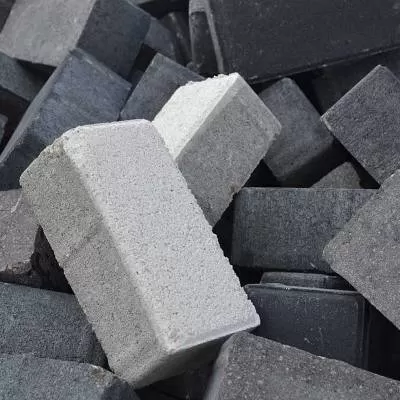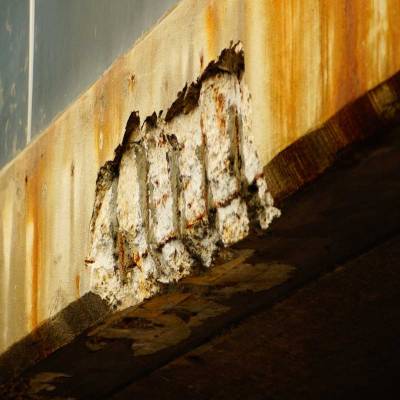- Home
- Building Material
- Concrete
- Strengthening Concrete Performance
Strengthening Concrete Performance
In the second in a series of features showcasing experiences with building materials, Cyrus Dordi, Corporate Head (PQM & CSG), Ambuja Cements Ltd, tells us about ultrafine slag as a micro-fine cementitious material.
Like other industry waste products, slag has many uses and rarely goes waste. It can be used in concrete and cement as well as in glass industries. Generally, Ground Granulated Blast Furnace Slag (GGBS) complies with Indian standards for use in cement and concrete. Universally a useful cementitious material, slag as available waste may have its own shortcomings. However, it is a different story after it is ground and granulated to a fine or ultra fine powder.
Involved in civil works on large projects, Cyrus Dordi, Corporate Head (PQM & CSG), Ambuja Cements Ltd, has been through a professional journey of quality control on concrete and, now, cement. In conversation with Shriyal Sethumadhavan, he talks about ultrafine slag, its usage and how its dispersion effect improves concrete properties like workability, slump retention and cohesiveness in a fresh state, and strength and durability in a hardened state.
The material
Material technology in concrete has undergone tremendous change owing to demanding performance requirements. Fresh concrete demands a fairly high degree of cohesiveness, high workability, pumpability, slump retention and a self-compacting nature. One important change is the introduction of micro technology for high performance with fine and various other micro-sized (ultrafine) cementitious material.
Micro-fine cementitious particles like ultrafine slag are much finer than normal cement grains and coarser than associated products like silica fume. Ultrafine slag prevents the ingress of aggressive chemicals in concrete by diffusion and permeation and thus enhances the durability of concrete. The presence of ultrafine, cementitious and/or pozzolanic materials allows denser packing between cement particles and creates a ‘wall effect’ in the transition zone between the paste and the aggregate. The weaker interface zone is strengthened owing to the superior bond developed between these two phases. It also refines the concrete microstructure and enhances the degree of impermeability, thus greatly improving the strength and durability characteristics of concrete.
Recently, Ambuja Cement, in association with Counto Microfine Products Pvt Ltd, developed and introduced a new-generation, ultrafine, low-calcium silicate product: Alccofine 1203. Its basic raw material is slag, and it has distinct characteristics to enhance the performance of concrete. After several trials and field studies, we at Ambuja Cement realised that ultrafine slag is a highly advantageous material and can replace costlier materials in that range. Hence, we are now marketing this material just like we market our regular products.
Improving concrete
In ultrafine slag, properties like workability, cohesiveness, slump retention, flow-ability and segregation resistance are improved considerably. Better shape and particle-size distribution and the dispersing property of GGBS are the responsible factors. It can be considered to be a niche material for high-strength, high-performance concrete. But, I personally feel that it can also be advantageous for low-grade concrete (M30 to M55). Moreover, with the scarcity of natural sand nowadays, people have no choice but to opt for crushed sand. This crushed sand makes the mixture more cohesive, owing to which the plaster doesn’t come out properly, and the demand for water increases because the particles are not round like in natural sand. And therein lies the problem of ‘strength’, ‘application’ and other issues.
Ultrafine slag adds good workability and cohesiveness to cement and acts like a chemical admixture at times. Also, in the course of our field study, among various other materials in this category, we found that apart from being economical, this material also helps improve slump retention; that is, the workability of concrete.
Trial and use
Slag is a known product and people have been using it for ages. In fact, it was recently used in the construction of the tallest concrete structure in the world, Burj Khalifa. In India, many structures have also been constructed using slag cement, including the Bandra outfall project and its tunnel lining projects.
Thus, before using this material, we did not need to carry out extensive research. However, we did conduct trials where we designed concrete mixes by carefully selecting all the materials and their optimum proportions. We have studied this material as a binder by way of substitution of cement. It was then observed in terms of strength, workability and various other engineering properties. In fact, such trials have not only been carried out in our laboratory in Goa but have also been conducted in Mumbai, Gujarat and some other well-known laboratories in India, like Civil Aids in Bengaluru.
Slag has been used in the past as an important binder, especially since there is a combination of sulphates and chlorides in the ground water and sub-soil. This is either used in onsite mixing or by ready-mix companies in their concrete. In fact, we had offered some of our samples to RMC India Ltd, one of the largest readymix companies in India. Today, they are using this material quite successfully in high performance concrete mixes. Ultrafine slag can be best used in high-rise construction, which requires concrete that goes above the M60 grade. Lodha Developers are also reviewing this material in their upcoming World One project in Mumbai. Apart from high-rise buildings, ultrafine slag can also be used in an aggressive environment that is overpowered with chlorides and sulphates (off -shore structures).
Adding strength
To strengthen concrete, ultrafine slag can be used in various proportions. It can be substituted in portions of 5 to 15 per cent depending on usage and optimisation. But, there is no limitation; you can use as much as 60 per cent slag as per the code. The international/national codes recommending the usage of GGBS in concrete are ASTM C989-05 (standard specification for GGBS for use in concrete and mortar) and IS 456-2000, which recommends GGBS usage in concrete/mortar.
The making
As a waste product of steel, initially, ultrafine slag is derived in a molten form, quenched and then solidified into a coarse material, which resembles cement. It is then ground and granulated, controlling the particle size distribution, till it becomes ultra fine, with a mean particle size value of 5 micron. This makes it more reactive. Therefore, being a waste material derived from steel, ultrafine slag also serves as a good sustainable material. By using this material, you replace cement to some extent. In the case of ordinary Portland cement, 1 tonne produces an equal amount of carbon dioxide. Thus, using slag or ultra-fine slag, in a way, reduces a good part of the total carbon dioxide emitted, and we are proud to be the pioneers of ultrafine slag in India.
Advantage ultrafine slag!
Improved durability: Resulting in a dense pore structure, which restricts the ingress of chloride and sulphate ions, this green material, unlike other equivalent material, makes concrete more alkaline, thereby protecting the reinforced steel in concrete and providing a durable structure.
Improved strength gain: Ultrafine slag results in the formation of a dense pore structure, and in-built Ca(OH)2, due to cement hydration, provides an increased secondary hydrated product resulting in improved strength gain at early as well as later stages.
Improved workability and cohesiveness and reduced shrinkage: Having better particle-size distribution compared to other supplementary cementitious materials (SCMs), which provide a dense matrix pore structure resulting in better workability, cohesiveness and superior volume stability (shrinkage).
Better retention of workability: Offering better compatibility with cement and certain chemical admixtures, its physical/chemical structure on hydration improves the workability retention properties of fresh concrete.
Reduced segregation: Ultrafine slag improves particle packing in the cementitious paste by filling cement particle voids by virtue of proper distribution of particles, whereby it reduces the bleed water and results in more homogeneous concrete with reduced segregation.
Improved flow ability: The material has better particle packing, which results in improved rheology resulting in improved flowability.
Retention of alkalinity: Ultrafine slag has lime content of about 34 per cent that, during hydration, helps retain higher alkalinity in pore solution, thereby mitigating corrosion.
Would you like to share your experience with any material? Write in at feedback@ASAPPmedia.com
- Construction
- Update
- Portal
- Magazine
- CW-India
- April
- 2011
- India
- Cyrus Dordi
- Ambuja Cements Ltd
- cementitious material
- Ground Granulated Blast Furnace Slag
- concrete
- cement
- cohesiveness
- micro technology
- ultrafine slag
- Counto Microfine Products Pvt Ltd
- GGBS
- chemical admixture
- Burj Khalifa
- Goa
- Mumbai
- Gujarat
- RMC India Ltd
- Lodha Developers
- World One
- Portland cement
- SCMs
In the second in a series of features showcasing experiences with building materials, Cyrus Dordi, Corporate Head (PQM & CSG), Ambuja Cements Ltd, tells us about ultrafine slag as a micro-fine cementitious material. Like other industry waste products, slag has many uses and rarely goes waste. It can be used in concrete and cement as well as in glass industries. Generally, Ground Granulated Blast Furnace Slag (GGBS) complies with Indian standards for use in cement and concrete. Universally a useful cementitious material, slag as available waste may have its own shortcomings. However, it is a different story after it is ground and granulated to a fine or ultra fine powder. Involved in civil works on large projects, Cyrus Dordi, Corporate Head (PQM & CSG), Ambuja Cements Ltd, has been through a professional journey of quality control on concrete and, now, cement. In conversation with Shriyal Sethumadhavan, he talks about ultrafine slag, its usage and how its dispersion effect improves concrete properties like workability, slump retention and cohesiveness in a fresh state, and strength and durability in a hardened state. The material Material technology in concrete has undergone tremendous change owing to demanding performance requirements. Fresh concrete demands a fairly high degree of cohesiveness, high workability, pumpability, slump retention and a self-compacting nature. One important change is the introduction of micro technology for high performance with fine and various other micro-sized (ultrafine) cementitious material. Micro-fine cementitious particles like ultrafine slag are much finer than normal cement grains and coarser than associated products like silica fume. Ultrafine slag prevents the ingress of aggressive chemicals in concrete by diffusion and permeation and thus enhances the durability of concrete. The presence of ultrafine, cementitious and/or pozzolanic materials allows denser packing between cement particles and creates a ‘wall effect’ in the transition zone between the paste and the aggregate. The weaker interface zone is strengthened owing to the superior bond developed between these two phases. It also refines the concrete microstructure and enhances the degree of impermeability, thus greatly improving the strength and durability characteristics of concrete. Recently, Ambuja Cement, in association with Counto Microfine Products Pvt Ltd, developed and introduced a new-generation, ultrafine, low-calcium silicate product: Alccofine 1203. Its basic raw material is slag, and it has distinct characteristics to enhance the performance of concrete. After several trials and field studies, we at Ambuja Cement realised that ultrafine slag is a highly advantageous material and can replace costlier materials in that range. Hence, we are now marketing this material just like we market our regular products. Improving concrete In ultrafine slag, properties like workability, cohesiveness, slump retention, flow-ability and segregation resistance are improved considerably. Better shape and particle-size distribution and the dispersing property of GGBS are the responsible factors. It can be considered to be a niche material for high-strength, high-performance concrete. But, I personally feel that it can also be advantageous for low-grade concrete (M30 to M55). Moreover, with the scarcity of natural sand nowadays, people have no choice but to opt for crushed sand. This crushed sand makes the mixture more cohesive, owing to which the plaster doesn’t come out properly, and the demand for water increases because the particles are not round like in natural sand. And therein lies the problem of ‘strength’, ‘application’ and other issues. Ultrafine slag adds good workability and cohesiveness to cement and acts like a chemical admixture at times. Also, in the course of our field study, among various other materials in this category, we found that apart from being economical, this material also helps improve slump retention; that is, the workability of concrete. Trial and use Slag is a known product and people have been using it for ages. In fact, it was recently used in the construction of the tallest concrete structure in the world, Burj Khalifa. In India, many structures have also been constructed using slag cement, including the Bandra outfall project and its tunnel lining projects. Thus, before using this material, we did not need to carry out extensive research. However, we did conduct trials where we designed concrete mixes by carefully selecting all the materials and their optimum proportions. We have studied this material as a binder by way of substitution of cement. It was then observed in terms of strength, workability and various other engineering properties. In fact, such trials have not only been carried out in our laboratory in Goa but have also been conducted in Mumbai, Gujarat and some other well-known laboratories in India, like Civil Aids in Bengaluru. Slag has been used in the past as an important binder, especially since there is a combination of sulphates and chlorides in the ground water and sub-soil. This is either used in onsite mixing or by ready-mix companies in their concrete. In fact, we had offered some of our samples to RMC India Ltd, one of the largest readymix companies in India. Today, they are using this material quite successfully in high performance concrete mixes. Ultrafine slag can be best used in high-rise construction, which requires concrete that goes above the M60 grade. Lodha Developers are also reviewing this material in their upcoming World One project in Mumbai. Apart from high-rise buildings, ultrafine slag can also be used in an aggressive environment that is overpowered with chlorides and sulphates (off -shore structures). Adding strength To strengthen concrete, ultrafine slag can be used in various proportions. It can be substituted in portions of 5 to 15 per cent depending on usage and optimisation. But, there is no limitation; you can use as much as 60 per cent slag as per the code. The international/national codes recommending the usage of GGBS in concrete are ASTM C989-05 (standard specification for GGBS for use in concrete and mortar) and IS 456-2000, which recommends GGBS usage in concrete/mortar. The making As a waste product of steel, initially, ultrafine slag is derived in a molten form, quenched and then solidified into a coarse material, which resembles cement. It is then ground and granulated, controlling the particle size distribution, till it becomes ultra fine, with a mean particle size value of 5 micron. This makes it more reactive. Therefore, being a waste material derived from steel, ultrafine slag also serves as a good sustainable material. By using this material, you replace cement to some extent. In the case of ordinary Portland cement, 1 tonne produces an equal amount of carbon dioxide. Thus, using slag or ultra-fine slag, in a way, reduces a good part of the total carbon dioxide emitted, and we are proud to be the pioneers of ultrafine slag in India. Advantage ultrafine slag! Improved durability: Resulting in a dense pore structure, which restricts the ingress of chloride and sulphate ions, this green material, unlike other equivalent material, makes concrete more alkaline, thereby protecting the reinforced steel in concrete and providing a durable structure. Improved strength gain: Ultrafine slag results in the formation of a dense pore structure, and in-built Ca(OH)2, due to cement hydration, provides an increased secondary hydrated product resulting in improved strength gain at early as well as later stages. Improved workability and cohesiveness and reduced shrinkage: Having better particle-size distribution compared to other supplementary cementitious materials (SCMs), which provide a dense matrix pore structure resulting in better workability, cohesiveness and superior volume stability (shrinkage). Better retention of workability: Offering better compatibility with cement and certain chemical admixtures, its physical/chemical structure on hydration improves the workability retention properties of fresh concrete. Reduced segregation: Ultrafine slag improves particle packing in the cementitious paste by filling cement particle voids by virtue of proper distribution of particles, whereby it reduces the bleed water and results in more homogeneous concrete with reduced segregation. Improved flow ability: The material has better particle packing, which results in improved rheology resulting in improved flowability. Retention of alkalinity: Ultrafine slag has lime content of about 34 per cent that, during hydration, helps retain higher alkalinity in pore solution, thereby mitigating corrosion. Would you like to share your experience with any material? Write in at feedback@ASAPPmedia.com
























